Question and Answer – November 2007
Note from Neil: We really enjoy getting your questions. While I’m not able to reply to them individually, we choose the ones of widest general interest or importance. (Plant ID questions are often of use only to the individual and are better handled at a garden center.) Conditions in Texas vary greatly from region to region. I must have your home city in order to give you an accurate reply. A digital photo helps, and it also improves the odds that your question will be included. Click here to e-mail your question.
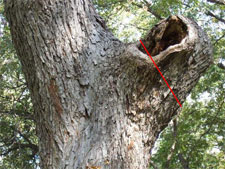
Proper Cut for Pecan Tree
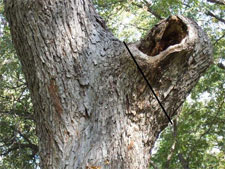
Branch Collar Cut for Pecan Tree
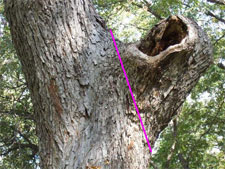
Outdated Flush Cut for Pecan Tree
Question: We had our pecan trees trimmed and there was one limb on one of the trees that my husband and I thought should have been trimmed closer to the tree because there is a hugh hole that will collect water and we feel like it will cause the tree to rot. The tree trimmer didn’t agree with us. I am attaching pictures and would appreciate hearing from you on how you think this should have been handled.
I.W., Dallas.
Answer: Just where to prune stubs of this sort is always confusing and different skilled arborists will probably have different opinions. However, I forwarded your note on to Steve Houser, Arborilogical Services of Dallas/Fort Worth. In spirit of full disclosure, his firm is an advertiser in several of my products, but he is also the most skilled arborist I have known. Here is his expert reply.
"There are good reasons for an arborist to leave what may appear to be a "stump" on the tree to the untrained eye. However, I do not see any advantage to be gained by leaving the cut in its present location.
"The attached "proper cut" photo shows that the previously formed callous tissue at the top of the old wound should be preserved and not removed (the line shows the proper cut angle and location). The "branch collar" photo (attached) shows the normal location of a proper cut but the callous tissue would be removed making it a less than an ideal location. In this case, a proper cut would leave the callous tissue at the top but also appear to leave a slight "stump". A cut in this location will heal faster with minimal rot or decay."
"A photo of the old and outdated "flush cut" location was included to show that this type of cut is much larger plus it would take forever to heal."
"Thank you for the opportunity to address this!!!!"
Steve
Question: I have two Mexican fan palms that are two years old. Last year I was able to wrap their trunks and leaves, but this year they’re too large. Is it just the trunks I need to worry about?
P.D., no city given.
Answer: Mexican fan palms are winter-hardy to 10 F or slightly below. Really, that translates into Zone 8. You didn’t say where you live, so the answer is problematic at best. Use lightweight frost cloth over the foliage and a heavier wrap on the trunks. Your most critical challenge will be to protect the growing tip.
Question: We transplanted this tree 25 years ago. We were told it was a date tree, but the fruit does not taste anything like dates. What can I do with it?
M.B., Irving.
Answer: This is a jujube tree (Zizyphus jujuba). It is not in any way related to date palms, but the fruit is often referred to as if it were. It’s a handsome plant with unusual branching. Do a little web-searching using its scientific name to see how you might best use the fruit.
Question: Why would our live oaks have black spots on their leaves? We also see small dead limbs within the trees. Is this some type of fungus?
L., Fort Worth.
Answer: You probably have seen a fungal leaf spot brought on by all the wet weather in late spring and early summer. Many oaks lost half or more of their foliage. That’s probably what happened to your twigs and small branches as well. There is nothing you should do now. Your tree should be fine come spring.
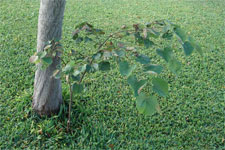
Question: I planted this redbud for my daughter about 12 years ago, so it does have a lot of sentimental value. Without going into too much detail, approximately half the tree canopy has died and the other half is right behind it. I was going to cut it down and replant until I saw this healthy growth develop. Some of the leaves are definitely darker green and glossy like the mother tree. Does this have the potential to develop into a strong replacement tree or should I start over? I’m not too concerned if it re-develops into an Oklahoma or regular eastern redbud. The new growth is coming up about 4 or so inches away from the main trunk.
D.M. Aledo
Answer: Leave the root sprouts in place. You probably noticed that Oklahoma redbuds have glossy leaves while regular eastern redbud leaves are more matte. Oklahoma plants are grafted, so any sprouts that develop below the bud union will be of the eastern redbud rootstock. My observation has been, over the years, that the life expectancy of the native redbuds is probably 30 to 40 years. I’ve seen a good many Oklahomas that haven’t made it that long. I’d leave the root sprouts in place to see what develops from them.
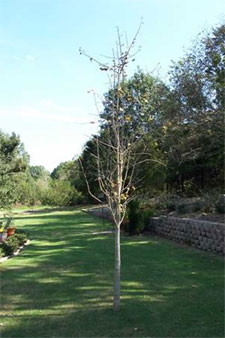
Question: I have a ginkgo tree that doesn’t look like it will become one of the world’s oldest living species. I have included some pictures from different angles and distances. I hope that you will tell why it continues to lose its leaves and what can I do to remedy the situation. It is a puzzle.
C.T.
Answer: Oh, how I wish you’d given your city. I simply can’t tell from e-mail addresses. If you live in an area with alkaline soil there is pretty good likelihood that this is cotton root rot. It’s a soil-borne fungus that lies dormant in the soil for years, then suddenly strikes down susceptible plants. The Plant Disease Diagnostic Laboratory at Texas A&M can confirm its presence from root samples. Other than environmental stresses such as drought and herbicide damage, I haven’t seen other issues with ginkgoes. If that ends up being the culprit you need to switch to a species that is immune. Some of your options would include cedar elm, Shumard red oak, chinquapin oak, bur oak, Little Gem magnolias and redbuds. Your landscape is very attractive and it looks like you need a somewhat upright tree in this spot (as the ginkgo should have been). Were it my yard I’d consider either Little Gem or, if you want something larger, cedar elm.
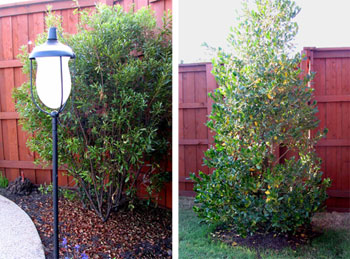
Question: The live oak, wax myrtle and Nellie R. Stevens holly were planted about a month ago. They are all showing signs of stress. What would cause this? I don’t want to lose them. Should I use a root stimulator or other fertilizer? How often and how much should I water them?
C.W. No city given.
Answer: This has to be shock from being moved to your landscape or from being planted. Since all of their roots were intact we’re going to assume it wasn’t from root loss. My best guesses would be that they either were blown in the wind on the way to your home or that they got too dry right after planting. In either case they should put some limited new growth out yet this fall. By spring they should be fine. It is not a nutrient issue, but a root stimulator applied one time now certainly wouldn’t hurt. Keep them moist all winter and spring. Hand-water them every 3 or 4 days from late spring through early fall next year. You didn’t ask, but it appears the wax myrtle might be a little close to the fence.
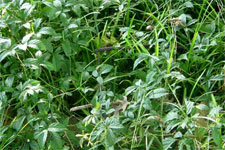
Question: I have a large area of mondograss in a tree-covered section of our property. There are some vines taking over everything there. What should I do next?
M.A.
Answer: Your mondograss certainly is full of these vines. I’m not sure if they’re dewberries or something else, but my answer would be the same – use a dandelion digger to cut their main stems where they enter the ground. You might also try mowing the bed at 3 inches at some point this fall or, more likely, next spring to set the vines back drastically and to even up the mondograss height. Fertilize the mondograss come early spring with a high-nitrogen or all-nitrogen plant food.
Question: Calyptocarups vialis, aka straggler daisy, is taking over my lawn, which is a blend of Floratam and bermudagrass. Is there anything I can spray on it to kill it? Every herbicide I find says not to use on Floratam.
V.G., Edinburg
Answer: Floratam is more sensitive than other grasses to broadleafed weedkillers and that’s why those disclaimers are on most weedkiller packages. Start by giving your Floratam St. Augustine the best possible care. Mow it regularly and keep it comparatively low (2 to 2-1/2 inches). Water it as needed and apply a high-nitrogen or all-nitrogen fertilizer to keep it strong. If the weed still persists you can try a spot-treatment of a broadleafed herbicide using a pump sprayer carefully along the weeds’ stems. Keep it off the Floratam as best you can. It probably won’t do damage, but you’ll minimize any impact it might have had if you apply it carefully.
Question: How large do our pecan trees need to be before I can make an above-ground flowerbed around it? We have a keystone retaining wall in our front yard and would like to make a circular raised bed around the pecan trees out of matching keystone. Is there a rule of thumb about the size of the tree trunk when we can safely do this and not risk damaging the tree?
E.R., Henderson.
Answer: If you’re not covering more than 10 or 15 percent of the root zone you probably won’t do any damage regardless of the size. Try to keep the soil out of direct contact with the trunk and its bark. Again, you didn’t ask, but a comment or two: that’s a difficult place to grow flowers. Most flowering plants need full sunlight. Also, look with a critical eye to see if such a bed would draw undue attention to the tree’s trunk. That’s not one of its most beautiful assets. Sometimes it’s better to have groundcovers around the trunk and position your color beds closer to the outside of the root zone.
Question: We have a large live oak that is dropping sap everywhere. What is the best, most environmentally responsible control for them?
B.M., Bedford.
Answer: That’s probably aphids and they will soon run their course. You’ll likely go years without seeing them again. I have never sprayed any of my shade trees for them over the years. We just move the lawn furniture and we park somewhere else for a few weeks. However, general-purpose insecticides work fairly well if they’re applied at first signs of the outbreak.
Question: My front yard has washed away due to the drought of the past several years. Now when it rains, I see little rivulets running beside the house to the street. I’m ready to redo the yard before my house leaves, too! My question is: How do I till around the exposed tree roots? We have crape myrtles, pecans and live oaks that are around 15 years old. I plan to add gypsum and compost during the tilling process but just don’t know what to do around the massive, exposed roots. Any suggestions?
S. H., Mesquite.
Answer: Figure first what you want to do with the bare ground. If you’re planning on turfgrass you don’t necessarily have to till very deeply, nor will you need to add compost. Gypsum is of limited value in black clay soils like you have no matter what you intend to plant there. If you decide to rototill even lightly, start by removing all but the inner set of tines from your tiller. That will allow you to till in very narrow areas. Mark the major roots and stay away from them and your trees will be fine. If you’re going to plant a groundcover you’ll want to till down 2 to 4 inches and add in compost, peat, finely ground pine bark mulch and well rotted manure. Use a vining type that will conceal the exposed roots.
Question: I have two elaeagnus bushes that I have trained tree-form. One died during all the rain. It seems supple, but I’m concerned that I’ve lost it. Any suggestions?
No name or city given.
Answer: If the soil remained waterlogged for several days, that might have been enough to kill it. The affected plant doesn’t appear to have much chance of coming back. Cotton root rot is another possibility, although elaeagnus is usually resistant.
Question: I had new landscaping installed in June. The crape myrtle’s leaves remained green but it never bloomed this summer. Is it okay to wait to see if it blooms next spring? I notified the contractor and he will make good on it but tells me it will be fine as long as the leaves are still green.
J.B., no city given.
Answer: You should definitely wait until spring. It will leaf out by late March, start growing and then, assuming it receives full sunlight, it will be blooming by summer. What you saw this season was a plant getting itself going as it established good roots. It will be just fine.
